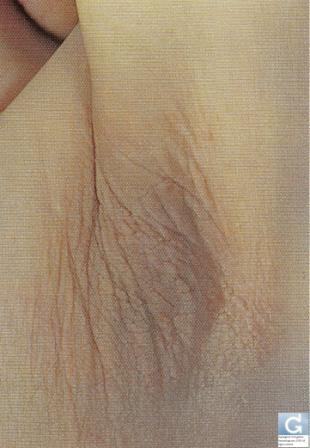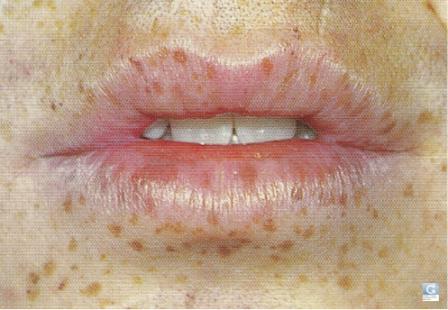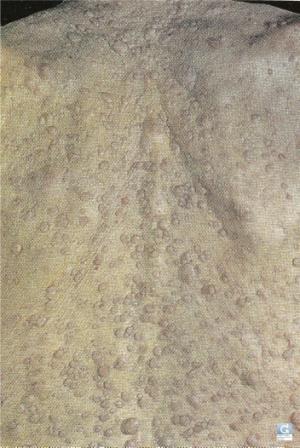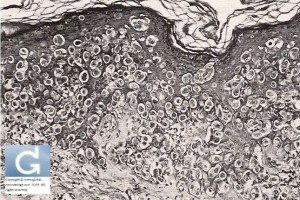Dr Christophe HSU – dermatologist. Geneva, Switzerland
The skin often reflects internal processes. Some skin lesions are linked to cancers and may serve as “signposts” indicating the presence of a less visible internal cancer. Awareness of such skin changes may thus result in earlier diagnosis and treatment of cancers. These skin lesions associated with cancers can be divided into 2 groups:
1. Skin diseases linked to internal cancer.
2. Skin diseases due to the direct spread of internal cancers to the skin.
1. Skin diseases linked to internal cancer.
- These skin diseases are often not intrinsically cancerous but may occur in individuals with internal cancers.
- Some of them occur at the same time as the cancers. Some of these skin diseases disappear after the cancer has been surgically removed and reappear when the cancer recurs.
- The presence of these skin diseases should prompt your doctor to look for underlying cancers. More often than not, no cancer are found to be present.
- Acanthosis Nigricans (AN)
- In this condition, the skin folds in areas such as the armpits, the neck and the groins appear thickened, dark and velvety. The nipples, navel, elbows and knees may also be affected.
- This skin disease may be associated with cancers in the gut and urine canal.
- AN often occurs simultaneously with the cancer and its course parallels that of the tumour.
- AN may be hereditary or associated with noncancerous diseases including diabetes mellitus, thyroid disease, hormone therapy and obesity.

- Acanthosis Nigricans
- Blistering Skin Disorders
- Pemphigus, a group of skin disorders characterised by fragile blisters, may be associated with tumours of any internal gland called the thymus gland. Patients with this internal tumour often suffer from myasthenia gravis, a condition marked by an increased tendency for muscles to be fatigue and weak.
- Your doctor will perform careful examinations and X’rays to look for such internal tumours when necessary.
- In another type of blistering skin diseases called paraneoplastic pemphigus, the disease is marked by skin blisters and erosions with severe soreness and ulceration of the mouth and genitals.
- This skin disease is always associated with a cancer of the cells of the lymph glands.
- A sunlight sensitive skin disease called porphyria cutanea tarda which presents with blisters and crusts over the sun-exposed skin, usually the hands, forearms and face, and sometimes associated with increased facial hair may occur in some patients with liver cancers.
- Dermatomyositis
- Patients with this skin disorder have sun-sensitive, purplish-red rashes on their eyelids, forehead, forearms and hands.
- Swelling of the affected skin is common.
- Muscle weakness often occurs.
- This skin disease may occur in patients with an internal cancer.
- Arsenical Keratoses
- This skin disease presents as corn-like hardening of the skin resulting from chronic ingestion of arsenic (common in Chinese traditional medicine)
- Arsenic may be found in some herbal medication which was especially used for the treatment of asthma previously.
- The skin lesions first develop on the palms and soles and subsequently the trunk and limbs. With the passage of time, each individual lesion may become cancerous.
- The skin disorder may be associated with cancers of the lung, throat and genito-urinary region.
- Paget’s Disease of the Nipple (EMP)
- Paget’s disease of the nipple presents as a red, crusted patch around the nipple.
- This skin disease which may be mistaken for eczema is often associated with breast cancer.
- Exfoliative Erythroderma
- Patients with this condition are red and scaly over practically their entire body surface. There may be swelling of the skin, fever and debilitation.
- About 10 to 15% of such patients have an internal cancer, the commonest of which is a lymphoma (a cancer of cells of the lymph glands).
- Peutz-Jegher’s Syndrome
- This condition is characterised by brown or black spots on the lips and inside the mouth.
- It is inherited in an autosomal dominant manner, but up to 50% of patients do not have any familial predisposition for the condition.
- A small percentage of these patients have associated cancer of the gut, breasts or ovaries.

- Peutz-Jeghers Syndrome
- Neurofibromatosis
- This condition is an inherited disorder.
- It is marked by multiple benign tumours (neurofibromas) on the skin.
- Two to 5% of the patients develop an internal cancer. These patients may develop tumours in the brain (astrocytoma, glioblastomas) and adrenal glands (phaeochromocytomas). Patients with neurofibromatosis who develop headache, backache or hypertension should be investigated for internal cancers.

- Neurofibromatosis
2. Skin Diseases due to Spread of Cancers to the Skin
- Any internal cancer can spread to the skin. Skin lesions due to the spread of internal cancers are called “metastases”.
- The tumours that most frequently give rise to skin metastases include lung cancer, colorectal cancer and breast cancer. The presence of metastases in the skin usually means that the internal cancer has spread to other organs as well.
- Site
- Certain sites appeared to be favoured by particular tumours although generalisations are not possible.
- For example, the scalp, face and neck are the commonest sites of metastases from breast, lung and oral cavity cancers.
- Metastases on the chest is most often from breast or lung cancer.
- The name “Sister Joseph’s nodule” has been given to metastases on the navel from cancer in the abdomen, pelvis or breast.
- Clinical Features
- Metastases in the skin may appear as single or multiple nodules.
- The nodules are usually firm or hard, fixed or mobile and non-tender.
- They often grow rapidly to 1 to 3 cm in diameter.
- The colour is variable and may be red, brown, blue, black or flesh coloured.
- Management
- When cutaneous metastasis is suspected, a specimen of the lesion should be surgically removed (skin biopsy) to confirm the diagnosis.
- If cancerous metastasis is confirmed the patient should undergo investigation to determine the site of the internal cancers.
- Treatment of the patient depends on the type of primary tumour, the degree of spread and the overall physical condition of the patient. Medical options for therapy include radiotherapy and chemotherapy.
Contributors
Dr Christophe Hsu – dermatologist. Geneva, Switzerland
National Skin Centre. Singapore
Tagalog Deutsch Italiano русский язык Português 日本語

